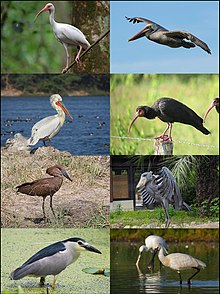Our website is made possible by displaying online advertisements to our visitors.
Please consider supporting us by disabling your ad blocker.
Pelecaniformes
| Pelecaniformes | |
|---|---|

| |
| Scientific classification | |
| Domain: | Eukaryota |
| Kingdom: | Animalia |
| Phylum: | Chordata |
| Class: | Aves |
| Clade: | Pelecanes |
| Order: | Pelecaniformes Sharpe, 1891 |
| Suborder and Families | |
The Pelecaniformes /pɛlɪˈkænɪfɔːrmiːz/ are an order of medium-sized and large waterbirds found worldwide. As traditionally—but erroneously—defined, they encompass all birds that have feet with all four toes webbed. Hence, they were formerly also known by such names as totipalmates or steganopodes. Most have a bare throat patch (gular patch), and the nostrils have evolved into dysfunctional slits, forcing them to breathe through their mouths. They also have a pectinate nail on their longest toe. This is shaped like a comb and is used to brush out and separate their feathers. They feed on fish, squid, or similar marine life. Nesting is colonial, but individual birds are monogamous. The young are altricial, hatching from the egg helpless and naked in most. They lack a brood patch.
The pelicans, shoebill and hamerkop form a clade within the order (suborder Pelecani). The relationships between Pelecani, herons (Ardeidae) and ibises and spoonbills (Threskiornithidae) are unclear. The Fregatidae (frigatebirds), Sulidae (gannets and boobies), Phalacrocoracidae (cormorants and shags), Anhingidae (darters), and Phaethontidae (tropicbirds) were traditionally placed in the Pelecaniformes, but molecular and morphological studies indicate they are not such close relatives. They have been placed in their own orders, Suliformes and Phaethontiformes, respectively.[3]
- ^ Mayr, G.; De Pietri, V. L.; Scofield, R. P.; Smith, T. (2018). "A fossil heron from the early Oligocene of Belgium: the earliest temporally well-constrained record of the Ardeidae". Ibis. 161 (1): 79–90. doi:10.1111/ibi.12600.
- ^ Kuhl, H.; Frankl-Vilches, C.; Bakker, A.; et al. (2020). "An unbiased molecular approach using 3'UTRs resolves the avian family-level tree of life". Molecular Biology and Evolution. 38: 108–127. doi:10.1093/molbev/msaa191. PMC 7783168. PMID 32781465.
- ^ Jarvis, Erich D.; et al. (2014). "Whole-genome analyses resolve early branches in the tree of life of modern birds". Science. 346 (6215): 1320–1331. Bibcode:2014Sci...346.1320J. doi:10.1126/science.1253451. hdl:10072/67425. PMC 4405904. PMID 25504713.
Previous Page Next Page


